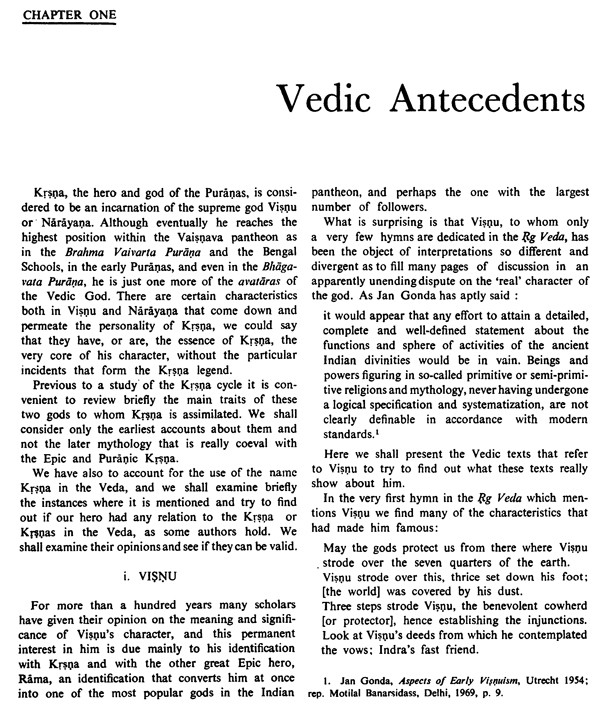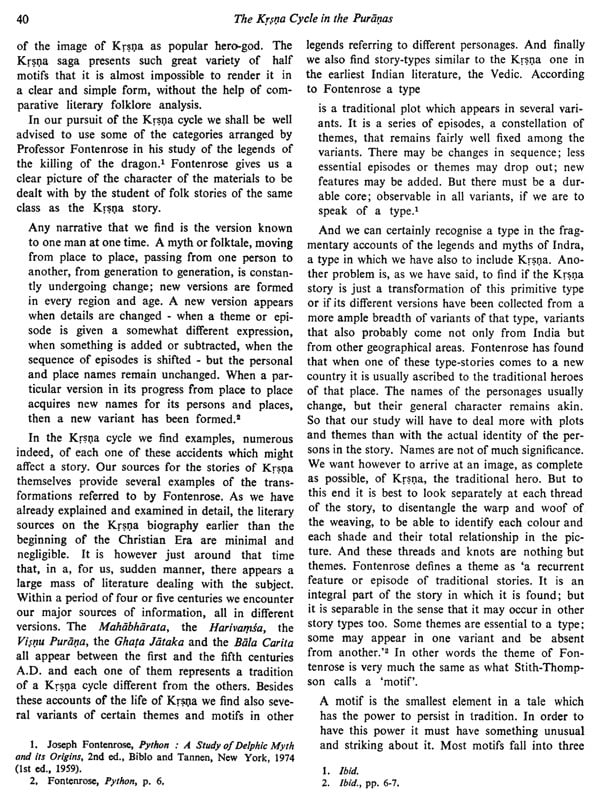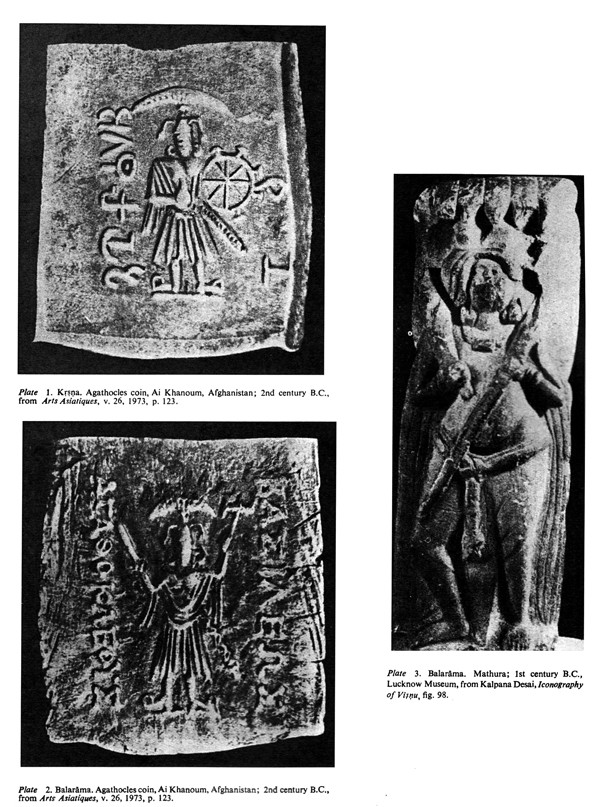
The Krsna (Krishna) Cycle in the Puranas (Themes and Motifs in a Heroic Saga)
Book Specification
| Item Code: | IDD575 |
| Author: | Benjamin Preciado - Solis |
| Publisher: | MOTILAL BANARSIDASS PUBLISHERS PVT. LTD. |
| Language: | English |
| Edition: | 1984 |
| ISBN: | 0895812266 |
| Pages: | 163(b & w illus: 74) |
| Cover: | Hardcover |
| Other Details | 10.8" X 8.6" |
Book Description
About the Book:
Krsna is one of the best loved figure in Indian religion and literature. The stories of his life and deeds occupy a central place in Indian literary traditions down to out day. The present work deals with the main themes and motifs found in the Krsna legend up to the 10th century.
In the first chapter the Vedic antecedents to the Krsna figure are examined, as well as some of the views that claim that Krsna is found in the Vedic hymns. The second chapter deals with the first historical evidence on Krsna up the beginning of the Christian Era, and an exhaustive survey is made of all the archaeological and literary evidence together with their interpretations and discussions by modern scholars. The third and fourth chapters analyse the themes and motifs in the Krsnasaga, presenting them in a folk-comparative method, paying particular attention to the resemblances to the legends of Hercules. The last chapter presents a general survey of the Krsna stories as presented in the iconography up to the 10th century. This is complemented by a collection of photographs of most of the Iconographical evidence discussed, many of them here published for the first time.
About the Author:
Dr. Benjamin Preciado-Solis, a Mexican scholar specialized in Indology, obtained an M. Phill. (in Philosophy) from the University of Guadalajara, Mexico; an M.A. (Indian Studies) from El Colegio de Mexico, and a Ph.D. (South Asian Civilization) from the Australian National University. He also spent a year in the Banaras Hindu University as a Ph.D. Research Scholar besides travelling several times to India in field trips for his investigation. He is now Professor of Indian Studies at El Colegio de Mexico and is currently engaged in the preparation of a book on Ancient Indian Art and another on the Evolution of traditional concepts in Indian Society.
When it was first suggested to me that I do research on Krsna, my immediate reaction was to say that the topic had been very well covered. I was, however, asked to consider it and so I did, with the result that I found that the topic was indeed very far from having been covered. Contrary to my first opinion I found that a full study of Krsna was still wanting. Many general-and in many cases superficial-accounts of Krsna and the Krsna-cult had been produced and there were also detailed studies of particular aspects of the topic-especially on Krsna's teaching in the Bhagavad Gita-but still it was obvious that a work covering in more detail the figure of Krsna was needed. So I decided to take up the investigation in the confidence that there was still much to say on the theme. However, as the months passed and I examined more and more material, it also became evident that Krsna alone was a very vast subject of research, and that anyone wanting to cover it in its totality, if he had all the necessary qualifications, would have to write a multi-volume work to do full justice to the topic. Thus I had to narrow the scope of my research to a manageable size. I chose to look into the stories . that formed the Krsna cycle and find more about them and their different versions. I would be dealing with the image of Krsna that is presented by the stories of the Puranas, first trying to identify some of the sources where these stories could have had their origins, and then examining the earliest historical evidence on Krsna and the Krsna-cult to see if any of these legends could be placed chronologically. I would have to examine then in detail some of the most characteristic episodes in the legends to identify their underlying themes and motifs. Finally, to complement this analysis of the stories, I decided to look also into their plastic repre- sentation in the Iconography. This was to be the scope of my research.
The advice of Professor Basham, for it was he who suggested I research this topic, proved to be very fruitful, and I think that, with his help, I obtained some good results in the analysis of the materials and that some original views are presented in this investigation, as well as some new evidence put for- ward to add to the store of knowledge on the subject. Earlier versions of parts of this research were presented to various Conferences. One part of chapter five was delivered as a paper at the Second National Conference of the Asian Studies Association of Australia, University of New South Wales, Sydney, Australia, May 1978; and parts of chapter three were delivered to the Staff Research Seminar, Faculty of Asian Studies, Australian National University, Canberra, Australia, 1978; the Second Congress of the Associacion Latinoamericana de Estudios Afro- asiaticos, Paipa, Colombia, April 1981; and the First International Symposium of the Sanskrit Language, Universidad Nacional A'ut6nomade Mexico, February 1982. Modified versions of parts of chapter five and chapter two were published in Australia and Mexico: "Dark as a Cloud," Hemisphere, vol. 23.2, 1979, Canberra, Australia; "Los Multiples Enigmas de Krsna", Dialogos 90, Nov.-Dec., 1979, Mexico; and "Primeras Evidencias Historicas sobre Krsna", Estudios de Asia y A/rica, vol. 15.4, 1980, Mexico.
I regret that I could not profit during my research of the magnificent book of Prof. Priyatosh Banerjee The Life of Krsna in Indian Art (National Museum, New Delhi, 1978).
I would like to thank the authorities and staff of the National Museum, New Delhi; Indian Museum, Calcutta; Government Museum, Madras; Archaeolo- gical Museum, Mathura; Archaeological Museum, Bhuvanesvar; Archaeological Museum, Jodhpur; and Bharat Kala Bhavan, Banaras Hindu University. Also to the authorities of the Archaeological Survey of India in Kanchipuram, Mahabalipuram, Aihole, Badami, Pattadakal, Ellora, Khajuraho, Deogarh and Udayagiri; as well as to the American Institute of Indian Studies, Ramnagar, Varanasi, who kindly provided plates 15, 19 and 56.
I also have to thank the authorities and staff of the following libraries : Library of the Madras University; Kuppuswamy Shastri Research Institute, Madras; and Adyar Library, Madras; Deccan College Research Institute and Bhandarkar Oriental Re- search Institute, Poona; Archaeological Survey of India, New Delhi; Banaras Hindu University Library, Varanasi; Victoria State Library, Melbourne, Aus- tralia; Sydney University Library, Sidney, Australia; and especially to the staff of the Australian National University Library-both at the Menzies and the Chifley Libraries. Also, the National Library of Australia and the British Museum Library and the S. o. A. S. Library, London, as well as other Australian and American University libraries that kindly provided materials for research. I also thank the Universidad de Guadalajara for the economic support during my studies in India and Australia.
It is now my very agreeable duty to acknowledge the help received from many teachers, colleagues and friends during the time of my research. First and foremost, to Professor A. L. Basham through whose invaluable guidance I was able to start, follow up and finish this project. Then to, Drs. B. J. Terwiel, K. H. J. Gardiner, R. Barz and T. Rajapatirana, all of the Australian National University, who helped me on numerous occasions. My thanks go also to Professor R. N. Dandekar, Dr. V. N. Shukla, Professor R. V. Joshi and the late Professor V. Raghavan for their advice and help. To Jackie Holyoake, Mary Hutchinson and Portia MacCusker for their kindness and help, and to my friends and colleagues K. Zysk, A. Galla, E. Perera, A. Ruelas, Carolyn Thornley and Maria and Carlos Amat for their advice and help with typing and reading. Also to Lie. Luis Echeverria, thanks to whose generosity and deep interest in learning and science, I have been able on two occa- sions, to visit and study in India. To the Australian National University my warmest thanks for their thorough support and liberality. To EI Colegio de Mexico and its Centre for Asian and African Studies as well as to Professors Victor L. Urquidi, Graciela De la Lama and Manuel Ruiz for their interest in this publication. Finally, most special thanks are due to my wife Magdalena and our daughters who have heroically, with love and understanding, put up with a very long research project.
**Contents and Sample Pages**














